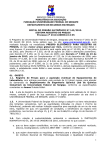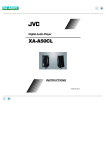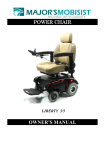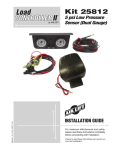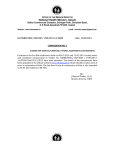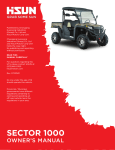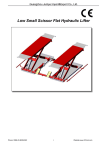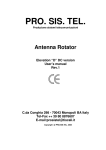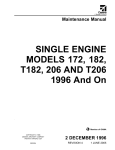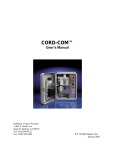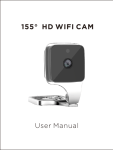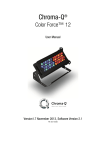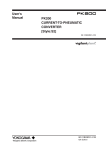Download Owner`s manual (Off-Road) 650GK
Transcript
Owner’s manual (Off-Road) 650GK READTHISMANUALCAREFULLY IT CONTAINS IMPORTANT SAFETY INFORMATION. MINIMUM RECOMMENDED OPERATOR AGE 0 650GK Limited Warranty The warranty policy applies to those cases where the new seller vehicle is unloaded from its shipping container, set up and delivered by authorized dealer, and under normal use and service is found to have defects in parts or workmanship under the following terms and conditions. This warranty covers the engine and engine related components for a period of 90 days. This warranty does not apply to any part, which in opinion of seller was defective because of improper maintenance, improper assembly, alterations, abuse, negligence or accident. Should warranty service be required on your 650GK during the 90 days warranty period, please contact your nearest authorized dealer for repairs. What is not covered under this warranty This warranty does not cover any seller vehicle that has been subjected to: a. This warranty does not cover any seller vehicle in any way so to adversely affect its safety or reliability. b. Renting c. Disassembly, adjusting, or repairing of the vehicle in any way so as to adversely affect its safety or reliability. d. Competition or racing The warranty does not cover loss of use of the seller vehicle, loss of time, inconvenience, or other consequential damage which includes, but is not limited to, loss or damage to persons or property or any expense of returning any damaged units to the seller distributor or its authorized dealer. Seller has the right to make changes without notice. 1 CONTENTS Page 1. FOREWORD------------------------------------------------------------------------------------------------------------------------------------ 3 2. A FEW WORDS ABOUT SAFETY--------------------------------------------------------------------------------------------------------- 4 3. IMPORTANT SAFETY INFORMATION------------------------------------------------------------------------------------------------- 5 4. SAFETY LABELS------------------------------------------------------------------------------------------------------------------------------ 7 5. ARE YOU READY TO DRIVE? ------------------------------------------------------------------------------------------------------------ 8 6. IS YOUR VEHICLE READY TO DRIVE? --------------------------------------------------------------------------------------------- 11 7. SAFE DRIVING PRECAUTIONS -------------------------------------------------------------------------------------------------------- 12 8. SPECIFICATIONS ----------------------------------------------------------------------------------------------------------------------------14 9. OPERATIONS -----------------------------------------------------------------------------------------------------------------------------------15 10. SERVICE INSTRUCTIONS ---------------------------------------------------------------------------------------------------------------- 20 11. REPAIR ----------------------------------------------------------------------------------------------------------------------------------------- 25 12. PERIODICAL CHECK AND SERVICE ------------------------------------------------------------------------------------------------- 36 13. WIRING DIAGRAM ------------------------------------------------------------------------------------------------------------------------- 37 2 FOREWORD Thank you for choosing this Go-kart. We hope you will have fun with it. Before you start to operate the Go-Kart, please read through this Owner’s Manual carefully as it contains important safety and maintenance information. Failure to follow the warnings contained in this manual can result in serious injuries. Be sure to follow the recommended maintenance schedule and service your kart accordingly. Preventative maintenance is extremely important to the longevity of your Go-Kart. We believes in conservation and protection of earth’s natural resources. To that end, we encourage every vehicle owner to recycle, trade in, or properly dispose of, as appropriate, used motor oil, coolant, and other fluids, batteries, and tires. We hope you will have a pleasant experience with our products. 3 A FORWORDS ABOUT SAFETY In order to keep everyone safe, you must take responsibility for the safe operation of your Go-Kart. To help you make informed decisions about safety, we have provided operating procedures and other information on labels and in this manual. This information alerts you to potential hazards that could hurt you or others. It is not practical or possible to warn you about all hazards associated with operating or maintaining a Go-Kart. You must use your own good judgment. You will find important safety information in a variety of forms, including: Safety Labels - On the Go-Kart. Safety Messages – Preceded by a safety alert symbol words: WARNING, or CAUTION. and one of two signal These signal words mean: Physical harm may result from failure to adhere to the instructions that are described within the WARNING labels. Safety Headings --- such as Important Safety Reminders or Important Safety Precautions. Safety Section --- such as Go- Kart Safety. Instructions --- how to use this Go –Kart correctly and safely. This entire manual is filled with important safety information----please read it carefully. 4 IMPORTANT SAFETY INFORMATION Your Go-Kart will provide you with many years of service and pleasure. Providing you take responsibility for your own safety and understand the challenges you can meet while driving. There is a lot you can do to protect yourself when you drive. You’ll find many helpful recommendations throughout this manual. The following are a few that we consider most important. Follow the Age Recommendation It is strongly recommended that no one under the age of 16 be permitted to drive this Go-Kart without adult supervision. Always Wear a Helmet It’s a proven fact: helmets significantly reduce the number and severity of head injuries. Always wear an approved motorcycle helmet. We also recommend that you wear eye protection, sturdy boots, gloves, and other protective gear. Drive Off-Road Only Your Go-Kart is designed and manufactured for off-road use only. The tires are not made for pavement, and the Go-Kart does not have turn signals and other features required for use on public roads. If you need to cross a paved or public road, get off and walk your Go-Kart across. Take Time to Learn & Practice Even if you have driven other Go-Kart, take time to become familiar with how this Go-Kart works and handles. Practice in a safe area until you build your skills and get accustomed to this Go-Kart’s size and weight. Because many accidents involve inexperienced or untrained drives, we urge all drivers to take a training course approved by the Go-Kart Safety Institute. Check with your dealer for more information on training courses. Be Alert for Off-Road Hazards The terrain can present a variety of challenges when you drive off-road. Continually “read” the terrain for unexpected turns, drop-offs, rocks, ruts, and other hazards. Always keep your speed low enough to allow time to see and react to hazards. Drive within Your Limits Pushing limits is another major cause of Go-Kart accidents. Never drive beyond your personal abilities or faster than conditions warrant. Remember that alcohol, drugs, fatigue, and inattention can significantly reduce your ability to make good judgments and driver safely. Don’t Drink and drive Alcohol and driving don’t mix. Even one drink can reduce your ability to respond to changing conditions, and your reaction time gets worse with every additional drink. So don’t drink and drive, and don’t let your friends drink and drive either. Never run your Go- Kart indoors. The exhaust from the engine contains a tasteless, odorless and poisonous gas called carbon monoxide. 5 IMPORTANT SAFETY INFORMATION Keep away from moving parts of the Go-Kart The operator of the Go-Kart should never place their hands or other parts of their body near any moving part of the Go-Kart. Failure to adhere to this warning will cause physical harm to your body. Skidding or Sliding The terrain surface can be a major factor affecting turns, Skidding a turn is more likely to occur on slippery surfaces such as snow, ice, mud and loose gravel. If you skid on ice, you may lose all directional control. To avoid skidding on slippery terrain, keep you speed low and drive carefully. 6 SAFETYLABELS This section presents some of the most important information and recommendations to help you drive your Go-Kart safely, please take a few moments to read these pages. The labels are considered permanent parts of the Go-Kart. If a label comes off or becomes hard to read, contact your dealer for warning labels replacements. 7 ARE YOU READY TO DRIVE? Before each drive, you need to make sure you and your Go-Kart are both ready to drive. To help get you prepared, this section discusses how to evaluate your driving readiness, what items you should check on your Go-Kart, and adjustments to make for your comfort, convenience, or safety. Before you drive your Go-Kart for the first time, we urge you to: ■ Read this owner’s manual and the labels on your Go-Kart carefully. ■ Make sure you understand all the safety messages. ■ Know how to operate all the controls. ■ Never drive this Go-kart if under 16 years old. Before each drive, be sure: ■ You feel well and are in good physical and mental condition. ■ You are wearing an approved motorcycle helmet (with chin strap tightened securely), eye protection, and other protective clothing. ■ You don’t have any alcohol or drugs in your system. Protective Apparel For your safety, we strongly recommend that you always wear an approved motorcycle helmet, eye protection, boots, gloves, long pants, and long-sleeved shirt or jacket whenever you drive. Although complete protection is not possible, wearing proper gear can reduce the chance of injury when you drive. The following suggestions will help you choose the proper driving gear. Helmets and Eyes Protection Your helmet is your most important piece of driving gear because it offers the best protection against head injuries. A helmet should fit your head comfortably and securely. An open-face helmet offers some protection, but a full-face helmet offers more. Regardless of the style, look for a DOT (Department of Transportation) sticker in any helmet you buy. Always wear a face shield or goggles to protect your eyes and help your vision. Operating this Go-Kart without wearing an approved motorcycle helmet, eye protection, and protective clothing could increase your chances of head and/or eye injury, possibly death in the event of severe accident. Always wear approved motorcycle helmet that fits properly and wear eye protection (goggles or face shield), gloves, boots, long-sleeved shirt or jacket and long pants. 8 ARE YOU READY TO DRIVE? Additional Driving Gear In addition to a helmet and eye protection, we also recommend: ■ Sturdy off-road motorcycle boots to help protect your feet, ankles, and lower legs. ■ Off-road motorcycle gloves to help protect your hands. ■ Driving pants with knee and hip pads, a driving jersey with padded elbows, and a chest/shoulder protector. Drive Training Developing your driving skills is an on-going process. Even if you have driven other Go-Karts, take time to become familiar with how this Go-Kart works and handles. Practice driving the Go-Kart in a safe area to build your skills. Do not drive in rough terrain until you get accustomed to the Go-Kart’s controls, and feel comfortable with its size and weight. Operating Go-Kart without proper instruction could increase your risk of an accident which could lead to serious injury or death. Attempt supporting with your hands to the ground when the Go-cart turning over could lead to serious injury or death. Never support with your hands to ground when the Go-cat will turn over. Age Recommendation It is strongly recommended that no one under the age of 16 be permitted this Go-Kart without adult supervision. A child driving a Go-Kart that is not recommended for his/her age could lose Go-Kart control and result in severe injury or death. A child under 16 should have adult supervision when operate on the Go-Kart. 9 ARE YOU READY TO DRIVE? No Alcohol or Drugs Alcohol, drugs and Go-Karts don’t mix. Even a small amount of alcohol can impair your ability to operate a Go-Kart safely. Likewise, drugs, even if prescribed by a physician, can be dangerous while operating a Go-Kart. Consult your doctor to be sure it is safe to operate a vehicle after taking medication. Operating this Go-Kart after consuming alcohol or drugs can seriously affect your judgment, cause you to react more slowly, affect your balance and perception, and could result in serious injury or death. Never consume alcohol or drugs before or while operating this Go-Kart. IS YOUR VEHICLE READY TO DRIVE? Before each drive, it is important to inspect your Go-Kart and make sure any problems you find are corrected. A pre-drive inspection is a must, not only for safety, but because having a breakdown, or even a flat tire, can be a major inconvenience. If your Go-Kart has overturned or has been involved in a collision, do not drive it until your Go-Kart has been inspected by your dealer, There may be damages or other problems you can not see. Improperly maintaining this Go-Kart or failing to correct a problem before driving can cause a crash in which you can be seriously hurt or dilled. Always perform a pre-drive inspection before every drive and correct any problems. Pre-drive Inspection Check the following items before you get on the Go-Kart: ■ ■ ■ ■ Engine Oil Check the level and add oil if needed. Check for leaks. Coolant Check the coolant and add coolant if need. Check for the leaks. Fuel Check the level and add fuel if needed. Also make sure the fuel fill cap is securely fastened. Check for leaks. Tires Use a gauge to check the air pressure. Adjust if needed. Also look for signs of damages or excessive wear. 10 IS YOUR VEHICLE READY TO DRIVE? ■ ■ ■ ■ ■ ■ ■ ■ ■ ■ ■ ■ ■ Nuts & Bolts Check the wheels to see that the axle nuts are tightened, Use a wrench to make sure all accessible nuts, bolts, and fasteners are tight. Pre-drive Inspection Underbody & Exhaust System Check for, and remove any dirt, vegetation or other debris that could be fire hazard or interfere with the proper operation of the Go-Kart. Air Cleaner Check the air filter. Replace it if needed. Leaks, Loose Parts Walk around you Go-Kart and look for anything that appears unusual, such as a leak or loose cable. Lights Make sure the headlight, brake light and tail light are working properly. Throttle Check the free play and adjust if needed. Press the throttle to make sure it moves smoothly without sticking, and snaps back automatically when it is released. Clutch cable Check the free play of clutch cable and adjust if needed. Press the clutch cable to make sure it moves smoothly without sticking, and snaps back automatically when it is released. Brakes Press the brake pedal several times, check for proper brake pedal free play. Make sure there is no brake fluid leakage. Engine Stop When engine is running, turn the switch key counterclockwise. Make sure engine stops. Steering Wheel Check that the wheels turn properly as you turn the steering wheel. Cable Check the cable housing for wear. Check the fittings are tight. Replace or tighten as needed. Tie rod Check the tie rod housing for wear. Check the fittings are tight. Replace or tighten as needed. 11 SAFE DRIVING PRECAUTIONS Off-Road Use Only Your Go-Kart and its tires are designed and manufactured for off-road use only, not for pavement. Driving on pavement can affect handling and control. You should not drive your Go-Kart on pavement. Operating this Go-Kart on paved surfaces may seriously affect handling and control of the Go-Kart, and may cause the vehicle to go out of control. Never operate the Go-Kart on any paved surfaces, including sidewalks, driveways, parking lots and streets. When driving off-road, also remember to always obey local off-road driving laws and regulations. Obtain permission to drive on private property. Avoid posted areas and obey “no trespassing” signs. You should never drive your Go-Kart on public streets, roads or highways, even if they are not paved. Drivers of street vehicles may have difficulty seeing and avoiding you, which could lead to a collision. In many states it is illegal to operate Go-Karts on public streets, roads and highways. Operating this Go-Kart on public streets, roads or highways can cause collision with other vehicle. Never operate this Go-Kart on any public streets, roads or highways, even a dirt or gravel one. Keep Hands and Feet on Controls Always keep both hands on the steering wheel and both feet on the foot controls. When driving your Go-Kart. It is important to maintain your balance and control of the Go-Kart. Removing hands or feet away from the controls can reduce your ability to react and control the kart. Removing hand from Steering wheel or feet from foot controls during operation can reduce your ability to control the Go-Kart or could cause you to lose your balance and fall off the Go-Kart. Always keep both hand on the steering wheel and both feet on the foot controls of your Go-Kart during operation. 12 SAFE DRIVING PRECAUTIONS Control Speed Driving at excessive speed increases the chance of an accident. In choosing a proper speed, you need to consider the capability of your Go-Kart, the terrain, visibility and other operating conditions, plus your own skills and experience. Operating this Go-Kart at excessive speeds increases your changes of losing control of the Go-Kart, which can result in an accident. Always drive at a speed that is proper for your Go-Kart, the terrain, visibility and other operating conditions, and your experience. Use Care on Unfamiliar or Rough Terrain Before driving in a new area, always check the terrain thoroughly. Don’t drive fast on unfamiliar terrain or when visibility is limited. (it’s sometimes difficult to see obstructions like hidden rocks, bumps, or holes in time to react). Failure to use extra care when Operating this Go-Kart on unfamiliar terrain could result in the Go-Kart overturning or going out of control. Go slowly and be extra careful when operating on unfamiliar terrain. Always be alert to changing terrain conditions when operating the Go-Kart. Never drive past the limit of visibility. Maintain a safe distance between your Go-Kart and other off-road vehicles. Always exercise caution and use extra care on rough, slippery and loose terrain. Failure to use extra care when operating on excessively rough, slippery or loose terrain could cause loss of traction or vehicle control, which could result in an accident, including an overturn. Do not operate on excessively rough, slippery or loose terrain until you have learned and practiced the skills necessary to control the Go-Kart on such terrain. Always be especially cautious on these kinds of terrain. Do Not Perform Stunts You should always operate your Go-Kart in a safe and reasonable manner. When driving, always keep all four wheels on the ground. Attempting wheelies, and other stunts increases the chance of an accident, including an overturn. Never attempt stunts, such as wheelies or jumps. Don’t try to show off. 13 SPECIFICATIONS DIMENSIONS Overall Length--------------------------------------------------------------------------------------------------2730mm Overall Width ------------------------------------------------------------------------------------------------- 1700mm Overall Height -------------------------------------------------------------------------------------------------1480mm Wheelbase ------------------------------------------------------------------------------------------------------ 1925mm Front Track ---------------------------------------------------------------------------------------------------- 1440mm Rear Track ------------------------------------------------------------------------------------------------------1405mm Ground Clearance --------------------------------------------------------------------------------------------- 280mm ENGINE Type --------------------------------------------------------------------------------- 2-Bore,4-Stroke, Liquid-cooled Bore x Stroke -------------------------------------------------------------------------------------------- 76mm×71mm Displacement ------------------------------------------------------------------------------------------------------ 644 cc Compression ratio ------------------------------------------------------------------------------------------------8.4:1 Carburetor ------------------------------------------------------------------------------------ BJH101E or CSH101E Max Power --------------------------------------------------------------------------------------------20.6kw/5300rpm Maximum Torque ---------------------------------------------------------------------------44/2700~3300Nm/r/min Starting ----------------------------------------------------------------------------------------------------------- Electric Ignition ------------------------------------------------------------------------------------------------------------- C.D.I Lubrication -------------------------------------------------------------------------------------------- Force & Splash Transmission ----------------------------------------------------------------------- manual clutch, 4 shift/Reverse Spark Plug ---------------------------------------- --------------------------------------------------------F6T or F6TC Plug gap ---------------------------------------------------------------------------------------------------- 0.7±0.1mm Fuel type --------------------------------------------------------------------------------------------- RQ93 (unleaded) Lubricate oil -------------------------------------------------------------------------------------- ≥00C SAE-15W/40 <00C SAE-10W/30 CAPACITIES Maximum load ---------------------------------------------------------------------------------- -----------------200kg Fuel tank ------------------------------------------------------------------------------------------------------------ 23.0L Engine oil ----------------------------------------------------------------------------------------------------------2900ml Coolant -------------------------------------------------------------------------------------------------------------4000ml Starting ---------------------------------------------------------------------------------------------------------------- <5s Climbing ---------------------------------------------------------------------------------------------------------- 20°-25° Battery ---------------------------------------------------------------------------------------------------------- 12V32Ah Head Light ----------------------------------------------------------------------------------------------12V 150W/Both Tail Light ------------------------------------------------------------------------------------------------- 12V 80W/Both Fuse ---------------------------------------------------------------------------------------------------------------------30A SPECIFICATIONS Brake Track ----------------------------------------------------------------------------------------- < 7m @ 20miles/h Top speed ------------------------------------------------------------ 50 miles/h (or limited as customers require) CHASSIS Front, Rear brake --------------------------------------------------------------- Hydraulic disc, right foot control Front tire --------------------------------------------------------------------------------------------------------- 25×8-12 Rear tire ----------------------------------------------------------------------------------------------------------- 25×10-12 Front Suspension --------------------------------------------------------------------------- Independent Dual A-Arm Rear Suspension --------------------------------------------------------------------------- Independent Dual A-Arm Final Drive --------------------------------------------------------------------------------------------------- shaft driven TIRE PRESSURE Front ----------------------------------------------------------------------------------------- 70kpa 0.7kg/c ㎡ 10psi Rear ------------------------------------------------------------------------------------------ 70kpa 0.7kg/c ㎡ 10psi WEIGHT Net Weight ---------------------------------------------------------------------------------------------------------460kg WARRANTY Parts and workmanship -------------------------------------------------------------------------------------- 90 Days 14 OPERATION A. Operation controls WARNING-Do not attempt to start or operate the engine until completely familiar with the location and use of each control necessary to operate this vehicle. The operator must know how to stop this machine before starting and driving it. a. Throttle The right foot pedal is the throttle that controls the Go-Kart speed. To disengage the clutch at any time, allow the throttle to return to the idle position. (See Fig. 1) Each time prior to starting the engine, check the throttle assembly to ensure that when pedal is pushed all the way forward the assembly is working smoothly and returns to idle when released. Do not operate if pedal or engine throttle linkage fail to return to idle. If unable to correct the problem through lubrication, adjustment or replacement of worn parts, contact your dealer for assistance. b. Brake The brake is located on the middle of the three control pedals (See Fig. 1). Applying pressure to the pedal applies pressure to the brake caliper around the brake disc at the front and rear wheels and slows or stops the kart. c. Clutch The left foot pedal controls the clutch cable (See Fig. 1). With the pedal down, you can shift the shift lever. Improper operation of the clutch will lead to excessive wear of the clutch friction surface. Figure 1 15 OPERATION d. Start engine 1. Engage the park brake 2. Press the clutch pedal down, put the shift lever in neutral 3. Insert the key into the ignition-switch If the engine is cold; 1. Pull the choke out fully 2. Press down the clutch pedal Figure 2 3. Turn the key clockwise to the “on” position. Release the key and the clutch pedal when the engine starts. 4. Push the choke back slowly to allow the engine to run smoothly. Keep engine running for 1-2 minutes. 5. Push the choke back fully. If the idle of engine is not smooth, pull out the choke to find the best running position and keep running for a while long until the engine ryns smooth without choke. If the engine is warm; Press the throttle slightly and turn the key clockwise to the “on” position, release the key and the throttle when the engine starts. Each time prior to starting the engine, check the throttle assembly to ensure that when pedal is pushed all the way forward the assembly is working smoothly and returns to idle when released. Do not operate if pedal or engine throttle linkage fail to return to idle. If unable to correct the problem through lubrication, adjustment or replacement of worn parts, contact your dealer for assistance. Before you start the engine, check that the parking brake is engaged, and the gear shift lever is in neutral. Trying to start the engine in gear may damage the starter motor, clutch or gearbox. Release the key at once if the engine starts. Holding the key in start position when the engine is running will cause damage to the starter motor. If the engine does not start after 10 seconds, a second attempt to start the engine can be allowed. Improper operation will damage the engine. 16 OPERATION e. Engine stop key Important-stop key test. Before driving this vehicle, test the Engine Stop key to assure that it is operating properly. With the engine running, turn the key counterclockwise to the “off” position for the engine to shut down. B. Pre-Drive Inspection Perform this pre-drive inspection everyday before driving vehicle. If not performed, serious damage to the vehicle or personal injury may result. 1. Check for Engine Oil Level. Check for transmission Oil Level. Check for leaks, add oil if required. 2. Check the coolant. Check for leaks, add the coolant if required. 3. Check for Fuel Level. Add fuel as necessary and do not overfill. Check for leaks. 4. Check for Brakes. Depress the brake pedal several times, and then check for proper brake pedal free play. Make sure there is no brake fluid leakage. Adjust if necessary. 5. Check the clutch cable, Assure the cable snaps back and has a smooth operation. Ensure the clutch can operate smoothly. Adjust if necessary, or replace the clutch if necessary. 6. Check Tires. Check tires condition and pressure. The pressure on both Front and Rear tire is 12psi. 7. Check Throttle. Check for smooth operation. Ensure the throttle “snaps” back to idle. 8. Check Engine Stop key. Perform engine stop key test. Repair as necessary. 9. Check all Nuts, Bolts, and fasteners. Check wheels to see that all axle nuts and lug nuts are tightened properly. Check and tighten as necessary all other fasteners to specified torque. 10. Check Roll Cage Bars. Ensure all protective roll cage bars are in place before operating the Go-Kart. 12. Check Brake Light. Check for proper operation. 13. Check Wheels. Check for tightness of wheel nuts and axle nuts; check that axle nuts are secured by cotter pins. 14. Check Steering. Check for free operation and for any unusual looseness in any area. Always follow rules for safe operation and wear a helmet. 17 OPERATION C. Passengers The vehicle allows for two riders only. Combined maximum weight of driver and the passenger should not exceed 180kg or 400Ibs. D. Seat Adjustment The seat must always be securely fastened in the position which best allows the operator control of the foot pedals, steering wheel, and the remote stop key. Figure 4 a. Pull seat adjustment handle upward to disengage seat slide. b. Move seat to desired position. c.Be sure seat adjustment handle snaps back into place and that seat is locked into position. (See Fig. 4 ) Before attempting to adjust the seat ensure that engine of the Go-Kart is stopped. Never operate this Go-Kart when the provided seat is not securely fastened, to do so could result in a strong possibility of severe personal injury or loss of life. Before attempting to adjust the seat ensure that engine of Go-Kart is stopped. E. Parking Adjustment Park brake “OFF” Park brake “On” Figure 6 a. Pull the park brake lever up so that the unit can engage park brake. b. To release the unit, press button on front end of parking lever then push the parking lever to the bottom. c. Adjust the parking cable if necessary. 18 OPERATION F. Gear Shift Adjustment 1. Loosen the bolts. 2. Press down the clutch pedal fully. 3. Operate the shift lever as to change gearshift from 1 to 4 and reverse smoothly. 4. First, tighten bolt 1 with thread glue. Then second, tighten bolt 2 with thread glue. (See Fig. 7) Figure 7 G. Break-in The first month is most important in the life of your vehicle. Proper operation during this break-in period will help assure maximum life and performance from your new vehicle. The following guidelines explain proper break-in procedures. 1. After the engine starts, the engine is not allowed in high speed in the neutral gearshift. 2. Drive vehicle from stop to low speed slowly. 3. Avoid braking strongly. 4. Do not exceed the vehicle speed on the below schedule The speed of vehicle Max speed in each gear The first 1000 km 1st 2nd 3rd 4th Gear Gear Gear Gear 15 km/h 25km/h 40 km/h 70km/h H. Starting And Operating Instructions a. Before starting the engine, be sure that the driver is seated properly in the Go-Kart and tighten the seatbelt. b. Testing the Go-Kart in a open place at the beginning to learn how to start, turn and stop. c. Operate the Go-Kart slowly until you are familiar with it. d. The turning radius of this Go-Kart is small and agile, so the centrifugal force is very high when turning at high speed. Slow down to a more controllable speed when turning to prevent the Go-Kart from rolling over. e. To prevent vehicle from rolling over, be sure to only turn the vehicle at a slow more controllable speed. 19 SERVICE INSTRUCTIONS A.Service Air Cleaner Service air cleaner every 80 hours NOTE: Service more often under dusty conditions. a. Remove cleaner cover by bolt b. Remove air cleaner element 1 (See Fig. 9) c. Check the paper filter, if the filter is dusty, please replace with a new one. Figure 9 B. Engine Lubrication Engine oil replacement You must change the oil in the crankcase after the first 5 hours of operating of your new engine and after 10 hours of use thereafter. That will insure proper lubrication of internal parts and prevent costly repairs due to excessive wear. Figure 10 Figure 11 Figure 12 Figure 13 a. With the engine warm, put the vehicle on the level ground. b. Shut down the engine, put a collecting oil plate under the engine oil outlet. Loosen the oil outlet plug in the warm engine. Let the engine oil out fully (see Fig. 10). c. Tighten the engine oil outlet plug. d. Remove the oil filler cap (see Fig. 11), fill oil (SE 15W/40 or SF 15W/40) about 2.8 liters to the engine. e. Pull out the engine oil dip stick (see Fig. 12), confirm the corrective oil level in the crankcase (see Fig. 13). 20 SERVICE INSTRUCTIONS Check engine oil and recharge a. If the color of engine oil changes, you need to replace the engine oil. Replace the engine oil as above. b. Check the engine oil level, change if necessary from d as above. C. Transmission lubrication You must change the oil in the transmission after the first 5 hours of operating of your new engine and after 10 hours of use thereafter. That will insure proper lubrication of internal parts and prevent costly repairs due to excessive wear. Figure 14 Figure 15 a. Put the vehicle on the level ground. b. Shut down the engine, put a collecting oil plate under the transmission oil outlet. Loosen the oil outlet plug in the warm engine. Let the transmission oil out fully (see Fig. 15). c. Remove the iron dust plug, this plug has a magnet on it. Iron dust caused by moving parts will stick to the plug. Clean the iron dust from this dust plug. d. Tighten the transmission oil outlet plug and the iron dust plug. e. Remove dipstick of transmission (see Fig. 14), fill oil (GL-4 85W/90) about 1.9 liters. f. Insert the transmission dipstick, check the oil level in the transmission. Confirm the corrective oil level in the transmission (see Fig. 14). Check transmission oil If the color of transmission oil changes, you need to replace oil. Replace transmission oil as above. 21 SERVICE INSTRUCTIONS D. Engine Coolant You must check the coolant for level and leaks. If it is low, you need to refill coolant into the radiator (approximately 4000 ml). The lack of coolant will cause the engine to overheat. This can cause engine damage. The coolant should always be topped up, since the coolant can evaporate. Figure 16 Figure 17 Put the vehicle on level ground. 1. Turn the coolant cap counterclockwise and open the cap (see Fig. 16). 2. Pour fresh coolant to filler neck. 3. Start the engine at idle. 4. Increase the engine rev’s a few times 5. Repeat 2,3,4 till the coolant is at neck and no bubbles come up. 6. Refit the coolant cap, turn it clockwise and tighten it 7. Turn the reserve coolant case cap counterclockwise and open the cap (see Fig. 17). 8. Pour fresh coolant of the specified type into the reserve coolant tank till the coolant reaches 2/5 to 3/5 of the reserve coolant tank volume. 9. Close the reserve coolant case cap, turn it clockwise and tighten it Top up the reserve coolant If the coolant in the reserve tank is less than 2/5, it needs to be topped up. 1. Turn the reserve coolant case cap counterclockwise and open the cap. 2. Pour fresh coolant of the specified type into the reserve coolant tank till the coolant reaches 2/5 to 3/5 of the reserve coolant tank volume. 3. Close the reserve coolant case cap, turn it clockwise and tighten it Opening the radiator cap while the engine is hot can be hazardous. Opening the radiator cap can spray the high temperature coolant in your eyes, face and any parts of your body. This can result in severe injury. Never open the radiator cap while the engine is hot. 22 SERVICE INSTRUCTIONS New and used coolant can be hazardous. Children and pets may be harmed by new or used coolant. Continuous or brief contact with coolant may be dangerous for your health. Keep new and used coolant away from the children and pets. To minimize your exposure to new and used coolant, wear a long sleeve shirt and moisture-proof gloves(such as dishwashing gloves) when you change coolant. If coolant contacts your skin, wash thoroughly with soap and water. Wash any clothing or rags if wet with coolant. Recycle or properly dispose of used coolant. Failure to use the correct coolant or coolant not the same as one in the radiator or reserve case can harm your ATV. Engine damage may occur if you use coolant that does not meet the specifications. E. Spark Plug a. Remove the spark plug and inspect it each time you change the oil. (Use a spark plug wrench) The electrodes should be kept clean and free of carbon. The presence of carbon or excess oil will greatly reduce proper engine performance. If possible, check the spark plug gap (area between electrodes) using a wire feeler gauge. This specification is 0.025”~0.030”. b. Before installing spark plug coat threads lightly with graphite grease if possible, to ensure easy removal next time the spark plug Figure 18 needs inspection (see Fig. 18). 1. It is advisable to replace the spark plug at least once a year to insure easy starting and good engine performance. 23 SERVICE INSTRUCTIONS F. Carburetor Adjustment Never make unnecessary adjustments. The factory recommended settings are correct for most applications. It’s not necessary to disassemble the screw unless the carburetor needs to be replaced. Prepare a 50r/w tachometer before adjustment. a. Warm up the engine (5~10min) b. Tighten the air screw gently. Back out 2-3/8 turns counter clockwise (see Fig. 19). c. Connect the tachometer, adjust the throttle to limit the idle speed. The standard value is (1400RPM). d. Turn the air screw counter slowly and observe the RPM of the engine, stop adjusting as the RPM reaches the top speed. e. Adjust the screw and adjust the idle speed to an ideal value. f. Repeat step d and e until the rotate speed of engine stables. Figure 19 G. Cleaning Instructions Keep your kart clean. With a clean rag, wipe off and dirt and oil from around controls. Wipe off any spilled fuel and oil. Keep the engine clean of foreign object and be sure to check that air intake fan is free of debris for proper cooling. H. Kart Lubrication Lubricate vehicle every 90 days of use, Apply several drops of oil in specific points. I. Storage Instruction In the event your kart is not to be operated for periods in excess of 30 days or at the end of each driving season prepare for storage as follows: a. Drain fuel tank and carburetor by allowing engine to run out of fuel, or use a fuel stabilizer. b. Lubricate engine cylinder by removing the spark plug and pour one ounce of clean lubricating oil through the spark plug hole into the cylinder. Crank the engine slowly to spread oil and replace spark plug. c. Do not save or store gasoline over winter. Using old gasoline, which has deteriorated from storage, will cause hard starting and affect engine performance. Do not drain fuel while engine is hot. Be sure to move Go-Kart outside before draining fuel. 24 REPAIR A. Front Wheel Replacement Do not disassemble the center castle nuts when you replace the front wheels. (See Fig. 20) Tighten the nuts after replacing the wheels. Figure 20 B. Rear Wheel Replacement Do not disassemble the center castle nuts when you replace the front wheels. (See Fig. 21) Tighten the nuts after replacing the wheels. Figure 21 25 REPAIR C. Clutch replacement Do not remove the whole engine from vehicle when you replace the clutch, but you’ll need to remove rear suspension, driven shaft, clutch cable, muffler, wires and rubber cushion that is in the middle of transmission and frame. 1. Remove bolt M14 (See Fig. 22) Figure 22 2. Remove two bolts (M12) on the starter (See Fig. 23), Remove the starter (See Fig. 24) Figure 23 Figure 24 26 REPAIR 3. Remove two nuts (M14) on two side of transmission (See Fig. 25, 26) Figure 25 Figure 26 5. Remove two bolts(M8) on the low mud plate of transmission (See Fig. 27, 28) Figure 27 Figure 28 6. Remove the mud plate (See Fig. 21). Figure 29 27 REPAIR 7. Remove the transmission (See Fig. 30, 31) Figure 30 Figure 31 8. Remove upper mud plate (See Fig. 32) Figure 32 28 REPAIR 9. Insert a shaft into the hole (See Fig. 33). clutch (See Fig. 34) Remove six bolts on the pressing plate of Figure 33 Figure 34 10. Remove the pressure plate (See Fig. 35). Remove the friction disc of clutch (See Fig. 36, 37) Figure 35 Figure 36 Figure 37 29 REPAIR 10. Insert a special shaft into the hole, fix new friction plate on the flywheel of engine (See Fig. 38, 39). Figure 38 Figure 39 11. Fix pressure plate of clutch. Two bolts with “Y.G” mark must be inserted into two anchor hole (See Fig. 40) . Tighten six bolts with torque 30 N.m (See Fig. 41) Figure 40 Figure 41 12. Fix upper mud plate (See Fig. 42, 43) Figure 42 Figure 43 13. Fix parts according to reverse operation to the disassembly 30 REPAIR D. Timing chain 1. Fix the timing chain n the sprocket of crankshaft. Mark A on the sprocket of crankshaft must be in the middle of double white links of timing chain. 2. Fix the guide plate.。 3. Fix the tensional plate. 4. Fix the sprocket. Mark on the sprocket must be in straight line to the single white link on the timing chain. 31 REPAIR E. Distributor replacement 1. turn around the crank shaft (See Fig. 44), direct the line on the pulley of crankshaft straight to the 0 degree line on the cover of engine (See Fig. 46) Figure 44 Figure 45 Figure 46 2. Remove the rocker cover of head by removing two bolts (See Fig. 47) Figure 47 32 REPAIR 3. Check the anchor hole, if it is not on the direction shown by Fig. Repeat above 1 as to obtain the hole direction shown by Fig. 4. Insert the screwdriver into the hole, turn the drive of oil pump shaft untill parallel to the crankshaft (See Fig. 48,49) Figure 48 Figure 49 5. Align the mark 2 on the shaft of distributor to the mark 1 on the aluminum housing (See Fig. 50) Figure 50 33 REPAIR 6. Insert the distributor slowly to the hole (See Fig. 51). Confirm the direction of distributor is as per the figure (See Fig. 52, 53). Tighten the nut of distributor housing. Figure 51 Figure 52 Figure 53 7. Fix the cover of the distributor (See Fig. 44). Figure 42 34 REPAIR 8. Check the spark timing. Adjust if need as followings 1. Loosen the nut of the distributor housing 2. Turn the distributor slowly. Increase the spark timing by counterclockwise turn. Decrease the spark timing by clockwise turn. F. Front Wheel Alignment a. Put the vehicle on level ground. b. The “toe-in” of the front wheels should be 1.18 inches. To check for alignment, measure distance A and B between the centerline (CL) of the wheels. The proper toe-in dimension A should be 1.18 inches greater than dimension B. c. To adjust the alignments, loose the lock nuts on both sides of Front Tie Rods. To make Dimension B smaller, turn the rod to the left. Turn the rod to the right to make Dimension B larger. After adjusted to desired length, tighten the lock nut against the rod end. Recheck the dimensions for proper alignment. 35 PERIODICAL CHECK AND SERVICES The maintenance intervals in the following table are based upon average driving conditions. Driving in unusually dusty areas, require more frequent servicing. Time of service Initial Monthly Quarterly Yearly service Item Engine 1. Fan, driven belt 2. Tighten bolts on engine. 3. Engine oil 4. Coolant 5. Coolant hose and joints 6. Exhaust 7. Transmission oil Ignition 8. Coil 9. Distributor for ignition 10. Air cleaner 11. Throttle cable and choke 12. Fuel tank cover. Breathe hose and joint. 13. Idle 14. Breathe hose 15. Fuel hose and joints Control system 16. Wire and plugs 17. The free display of clutch pedal 18. Brake fluid, hose, joints 19. The free display of brake pedal, Brake 20. Parking 21. Brake shoes and disc Chassis 22. Tires 23. Tighten nuts on the hub and wheel 24. Shocks 25. Driven shaft 26. All nuts and bolts 27. Steering wheel, steering 28. Test vehicle I I I I I I I I I I I R I R I I C I R I.A.L I I.R I I I I.R I I.R.A I I I I I I I I.R I I I I I I.R R I I I I I I I I I I I A: adjust C: clean I: inspect, clean or replace if necessary. L: lubricate R: replace 36 I I I WIRING DIAGRAM 37








































